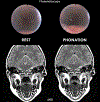Incorporating Velopharyngeal MRI into the Clinical Decision-Making Process for a Patient Presenting with Velopharyngeal Dysfunction Following a Failed Palatoplasty
- PMID: 37143294
- PMCID: PMC10624648
- DOI: 10.1177/10556656231173500
Incorporating Velopharyngeal MRI into the Clinical Decision-Making Process for a Patient Presenting with Velopharyngeal Dysfunction Following a Failed Palatoplasty
Abstract
This clinical report describes the implementation of magnetic resonance imaging (MRI) to evaluate a patient with long-standing velopharyngeal dysfunction. She was referred to the craniofacial clinic at age 10 with no prior surgical history and subsequently completed a Furlow palatoplasty due to a suspected submucous cleft palate. However, results were unfavorable with minimal improvement in speech or resonance. The clinical presentation, treatment, outcomes, and contributions from MRI for secondary surgical planning are described. Addition of MRI into the clinical workflow provided insights into the anatomy and physiology of the velopharyngeal mechanism that were unable to be obtained from nasendoscopy and speech evaluation alone.
Keywords: MRI; velopharyngeal dysfunction.
Conflict of interest statement
Declaration of Conflicting InterestsThe author(s) of this manuscript have no conflicts of interest to disclose with respect to the research, authorship, and/or publication of this article. This study was approved by the University of Virginia Institutional Review Board (IRB-HSR#200333).
Figures


References
-
- Kummer AW, Clark SL, Redle EE, Thomsen LL, Billmire DA. Current Practice in Assessing and Reporting Speech Outcomes of Cleft Palate and Velopharyngeal Surgery: A Survey of Cleft Palate/Craniofacial Professionals. The Cleft Palate-Craniofacial Journal. 2012;49(2):146–152. doi:10.1597/10-285 - DOI - PubMed
-
- Van Demark D, Bzoch K, Daly D, et al. Methods of assessing speech in relation to velopharyngeal function. Cleft Palate J. 1985;22(Journal Article). - PubMed
Publication types
MeSH terms
Grants and funding
LinkOut - more resources
Full Text Sources
Medical

